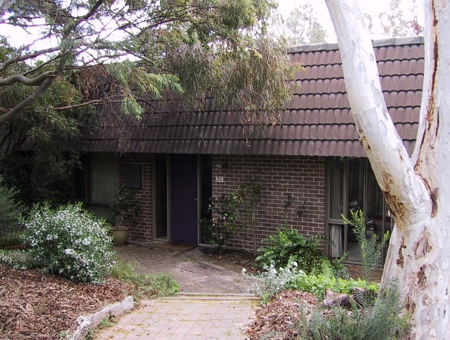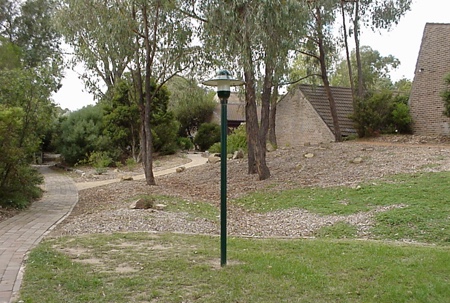Urambi Village, Crozier Circuit, Kambah (1974)

A singe level courtyard house
The idea of the Urambi Village Housing Cooperative, or Urambi Village as it is now known, was conceived by a group of public servants who came to Canberra to work in the Whitlam Government’s Federal Department of Urban and Regional Development in 1973. This group wanted to establish a new style of housing that provided a better environment and facilities than the standard single lot residential unit.
At the time, use of large blocks of land for medium density housing was prohibited by local planning regulations and it was necessary to change the land tenure laws to allow large sites such as Urambi and Wybalena Grove to be developed and sold through strata title. Public meetings were called to gauge interest in the concept and the Urambi Cooperative Community Advancement Society was formed to develop the village.
The Sydney architect Michael Dysart was commissioned to design both developments in 1974.
Significance
The housing group is a relatively rare and well-preserved example of 1970s housing in the late twentieth century Sydney regional style. The place exhibits the principle characteristics of modern residential architecture in a National Capital Development Commission planned neighbourhood suburb—appropriate human scale and functional domestic planning. The housing is notable for being situated within a natural bushland setting and the intact landscaping surrounding the buildings. The setting and the architecture combine to produce a precinct of integrity, illustrative of modern architecture.
Urambi is a well-preserved example of the move towards the introduction of diverse housing types procured through communal and co-operative processes for the purpose of demonstrating a socially responsible residential alternative and environmentally sensitive form of housing.
The real achievement of Urambi lies in the way the houses have been grouped to achieve a total result which is greater than the sum of the parts.
Urambi is the first of two examples of medium density housing designed by Michael Dysart in Canberra, one of Australia’s nationally noted architects. The other is Wybalena Grove in Cook.
The housing exhibits creative and artistic excellence as an entity possessing an architectural theme of modern architecture in the late twentieth-century Sydney regional style. The housing is aesthetically significant for its massing reflecting function and landform, juxtaposed with fine detailing, all expressed in the textural and tactile qualities of natural materials.
The Sydney Regional style
Urambi is an example of the late twentieth-century Sydney regional style of architecture with its asymmetrical massing, tiled skillion roofs (courtyard houses) and use of stained timber. Other architectural elements of the Sydney regional style displayed in these buildings that relate to the external forms are:
- clerestory windows
- exposed rafters
- timber decks
- timber awning sash
The following design features are of additional significance:
- site planning where the clusters are staggered across the site
- native landscape setting with paths and retaining walls
- brick courtyard walls
- external finishes—western red cedar framed glazing, panelled front doors, face brickwork
- timber balustrades
- separate covered car parking
- split-level designs, and original detailing and finishes

Pedestrian spine path
Description
The housing group is planned around the curve of the northwest crest of a low hill, set between a golf course and the elbow street corner formed by Crozier Circuit forming an inverted ‘L’ site plan. The residential groups are approached off vehicle circulation paths and the car accommodation, which is accessed off Crozier Circuit from five evenly spaced entry roads. The site has a mature native landscape of trees and shrubs.
The Murrumbidgee Country Club golf course forms the north and west edge of the site and is linked to the Canberra Nature park. The land slopes to the north and west with westerly views across to the Brindabella Mountains.
The houses were situated within an existing bush-land setting and further planting of Australian natives within the public areas has re-enforced the ‘naturalness’ of the setting. The 43 split-level houses are located closest to the circuit and are arranged in groups or clusters of three to seven, placed to form parallel rows of terraces. The clusters are serviced by six car parking areas comprising carports and visitor car parking spaces.
Extending around the north and northwest edge of the site facing onto the golf course are 29 ‘L’ planned single storey courtyard houses, in clusters of three to seven, placed to form enclosed and partly enclosed private courtyards for each house.
The design philosophy revolved around a pedestrian street with both arms leading to a community centre, forming an agora or public space.
Pedestrian access to the houses from the parking areas is by pathways. The complex has a communal meeting room, a swimming pool, ball court, seating areas, letterboxes and garbage collection areas. The entries to most dwellings, with their vertically panelled cedar doors, are placed seemingly without concern for a formal front façade.
All houses are constructed with brown tile pitched roofs, brown-grey face brickwork, stained exposed timber, and western red cedar framed glazing combining to provide a distinctive aesthetic appearance of textural unity. The different designs range from two to five bedroom dwellings. Spaces within the split-level dwellings are arranged on three levels taking advantage of the slope of the site, some with clerestory glazing and skylights.
By staggering the houses the external walls of adjacent dwellings help enclose the courtyards providing additional privacy, and combined with native planting, the whole provides a perception of buildings settled in the natural landscape following the contours of the hillside.
Urambi Village was awarded the RAIA ACT Chapter C S Daley Medal in 1982. In 2002 it was awarded the RAIA ACT Chapter 25 Year Award.
Source
- Alastair Swayn of Daryl Jackson Alastair Swayn Architects, Canberra
- Royal Australian Institute of Architects RSTCA Draft Citation for Urambi Village